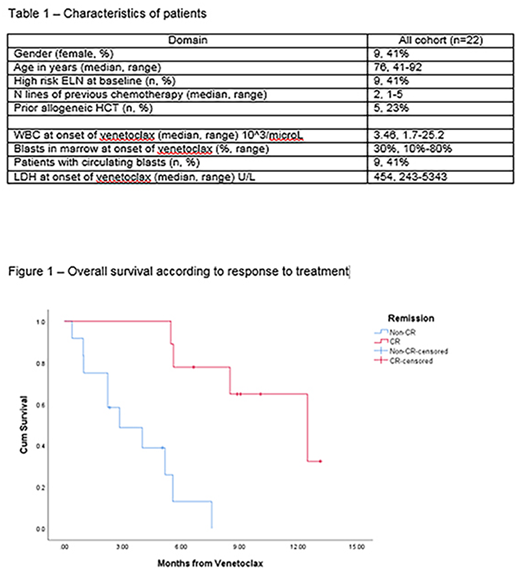Abstract
Introduction - Patients who experience relapse of acute myeloid leukemia or progress after exposure to hypomethylating agents (HMA's) have a dismal prognosis. Specifically, elderly patients lack effective salvage therapies in this setting. Venetoclax is a BCL-2 inhibitor that has shown substantial anti-leukemia activity in several early phase trials. We hypothesized that the addition of venetoclax to patients who previously failed HMA's might overcome resistance and improve outcome.
Methods - Patients (≥18 years) were eligible if leukemia relapsed after or was refractory to HMA. In general, in addition to venetoclax, patients continued HMA's or other low intensity therapies. Patients who previously underwent allogeneic hematopoietic stem-cell transplantation (HSCT) were also eligible; however they did not continue HMA and received donor lymphocyte infusion in addition to venetoclax. Data were analyzed on June 2018. The following domains were analyzed for correlation with CR and duration of survival: % of blasts in marrow and peripheral blood, LDH levels, age, acute leukemia ELN subgroup at diagnosis, number of previous chemotherapy lines, number of previous episodes of progression and the dose of venetoclax given. We used logistic regression to analyze predictors for response and Cox regression to analyze predictors for survival.
Results - Between October 2016 and March 2018 we treated 22 patients with acute myeloid leukemia that was refractory to HMA (azacitidine, n=20; decitabine, n=2). Median follow-up was 8.9 (range, 2.3-13.1) months. Table 1 depicts patients' characteristics. Median age was 76 (range, 41-92) years. Patients were given different doses of venetoclax (100mg, n=3; 200mg, n=9; 400 mg, n=8; 600mg, n=1; 800mg, n=1). After adjustment for concomitant medications (mainly azoles), only 2 patients were given less than the recommended 400 mg dose (both 200 mg). 17 patients (77%) developed at least one infectious episode. None experienced a major bleeding episode.
Nine patients (41%) achieved CR. Median time to CR was 62 days (range, 28-102). High LDH levels and a lower venetoclax dose were associated with lower incidence of CR (OR=.882, p=.047, and OR=.93, p=.087, respectively). Four patients are in ongoing remission (5, 5.8, 7.1, and 11 months post venetoclax). Median overall survival was 5.5 months (95% CI 5.1-5.9) for the whole group, while for patients achieving CR, the median OS was 12.5 months (95% CI 6.6-18.3), Figure 1. The following factors were associated with shorter survival - higher percentage of blasts in marrow (HR-1.035, p=.013), higher LDH levels (HR-1.29, p=.022), and peripherally circulating blasts (HR-1.03, p=.01).
For the subgroup of patients that relapsed after allogeneic HSCT (n=5), CR was achieved in 3 patients (60%) and the median OS was 12.4 months. 4/5 patients were given DLI in addition to venetoclax. One patient developed GVHD.
Conclusions - the addition of venetoclax to patients with HMA-refractory AML may result in a substantial anti-leukemic activity, specifically in those achieving complete remission. This should be further tested in a well designed prospective trial.
Zuckerman:Cellect Biotherapeutics Ltd: Consultancy.
Author notes
Asterisk with author names denotes non-ASH members.


This feature is available to Subscribers Only
Sign In or Create an Account Close Modal